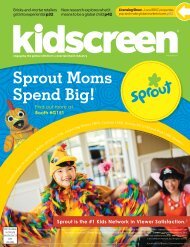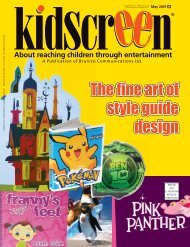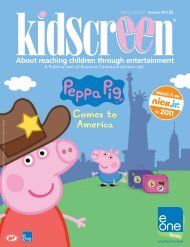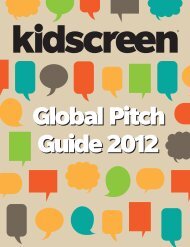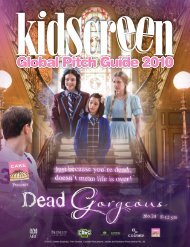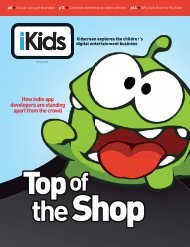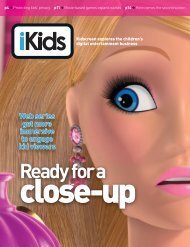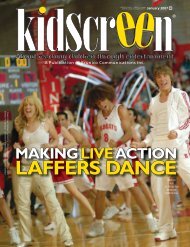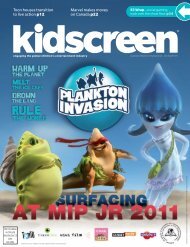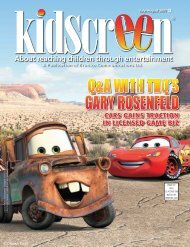rs ANIMATION SECIVRES CONTENTS - Kidscreen
rs ANIMATION SECIVRES CONTENTS - Kidscreen
rs ANIMATION SECIVRES CONTENTS - Kidscreen
Create successful ePaper yourself
Turn your PDF publications into a flip-book with our unique Google optimized e-Paper software.
According to Pete Denomme, CEO and executive producer<br />
at Yowza, the difference is substantial and has relegated the<br />
traditional hand-drawn technique to a few speciality features.<br />
“With hand-drawing, if you get 30 seconds a week from an<br />
animator you would be very lucky,” says Denomme. “Now you<br />
can get one to two minutes a week per animator.”<br />
Currently, even when a project strives to mine the nostalgic<br />
look of traditional hand-drawn animation, the economic<br />
benefi ts of using a software suite cannot be ignored.<br />
A case in point is Winnie the Pooh, a feature fi lm produced by<br />
Walt Disney Animation Studio and released in July 2011. The studio<br />
decided to use a hybrid of traditional hand-drawn animation<br />
and computer animation produced using Toon Boom’s Harmony<br />
suite. The results, according to Denomme, who has intimate<br />
knowledge of the production, showed that the new technology is<br />
essentially indistinguishable from the traditional animation. “You<br />
couldn’t pick out which parts were hand-drawn and which were<br />
computer-rendered,” he says. “That is why I think that Disney<br />
would do the next one fully in Harmony.”<br />
Another aspect that has helped the spread of Toon Boom’s<br />
Harmony as a major player in the production of 2D animation<br />
is the company’s approach to development. “It’s a very close<br />
relationship,” says Walker. “Toon Boom is driven by the industry.<br />
It is constantly working with produce<strong>rs</strong> to develop new<br />
tools. It’s not like they’re developed in a vacuum; there is a<br />
constant give and take.”<br />
By Gary Rusak<br />
2D<br />
Montreal, Canada-based Toon Boom Animation’s software is leading the charge in creating paperless 2D workfl ows<br />
The close relationship between Toon Boom and its clients<br />
has been a key component in developing innovations that<br />
have spurred more effi ciencies in tools that allow animato<strong>rs</strong><br />
to change characte<strong>rs</strong>, deform drawings and alter things like<br />
color palettes and line width with a simple key stroke.<br />
The next innovations from Toon Boom, according to Vogelesang,<br />
will mirror the world of computing in general with a<br />
bigger reliance on cloud computing and the integration of<br />
iPad and Android tablets into the pipeline.”It’s not standing<br />
still at all,” she says. “It’s moving forward because the demand<br />
is moving forward.”<br />
With a cost on the lower end ranging from US$200,000<br />
to US$250,000 for a 22-minute ep, 2D comes in about<br />
US$100,000 cheaper than its CGI counterpart. But produce<strong>rs</strong><br />
agree that saving money is not a good enough reason to<br />
chose one format over another.<br />
“You have to look at what is good for the project and then<br />
think about budget concerns,” says Julie Stall, VP of production<br />
at Toronto, Canada-based Portfolio Entertainment.<br />
It’s a familiar concept for Yowza’s Denomme. “These are all<br />
techniques to tell a particular story,” he says. “Some concepts<br />
don’t work for 3D and some don’t work for 2D. Everything<br />
starts on paper and from there we decide what method will be<br />
best to tell the story we want to tell.”<br />
However, there are a few axioms that hold true. For instance,<br />
the traditional 2D look seems to work well for a certain<br />
KIDSCREEN’S <strong>ANIMATION</strong> SERVICES ISSUE 2012<br />
21



